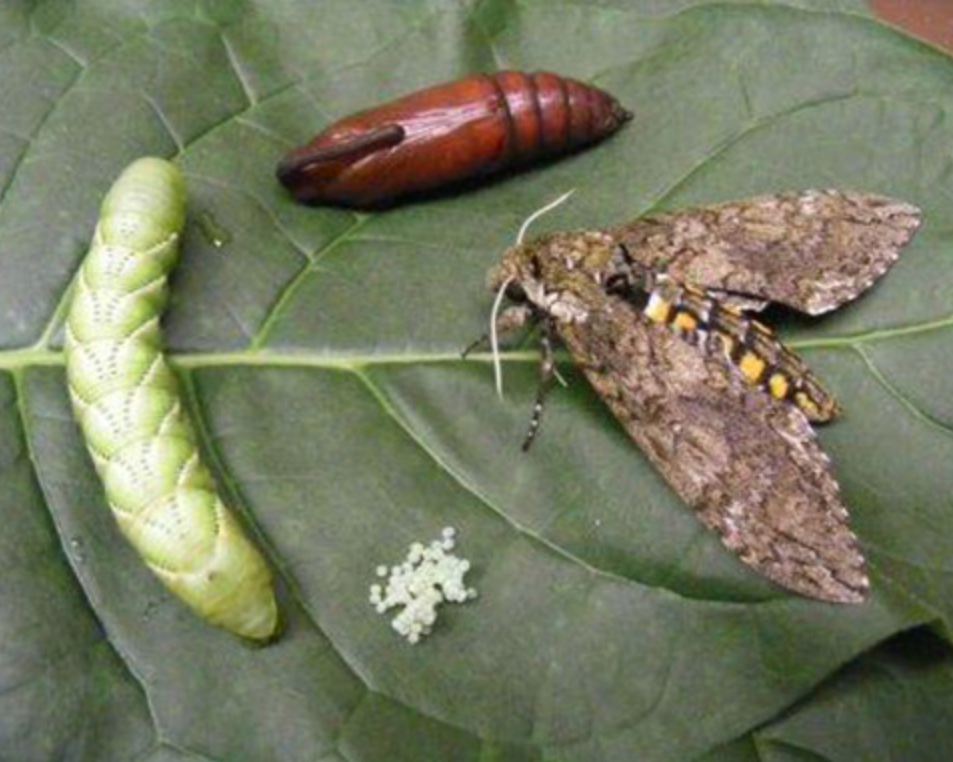The Tomato Tasmanian Devil: How to deal with Tomato Hormworms
I am a nature lover. I don’t like seeing nature die. Just the other day, I hit a squirrel while driving and I had a horrible pit in my stomach. However, if I am being honest, there are some things in nature that I have no pity for. One of them is the Tomato Hornworm. I strongly dislike them because they are greedy. They can ravage a tomato plant overnight it seems. Let’s talk about how to handle these little tasmanian devils that leave a path of destruction.
Spot them early
Regular monitoring is crucial for spotting tomato hornworms early and mitigating their impact on your garden. By routinely inspecting your tomato plants, particularly the underside of leaves, you can detect hornworm eggs and small larvae before they cause significant damage. Early detection allows for immediate action, such as handpicking or applying biological controls. Regular checks can also help identify the presence of moths, the adult form of hornworms, which lay eggs on the plants. Monitoring should be a daily routine during the growing season, ensuring any signs of infestation are promptly addressed to maintain healthy and productive tomato plants.
One telltale sign of a tomato hornworm infestation is the presence of their droppings, which resemble tiny green or black grenades. These droppings, known as frass, are cylindrical and slightly tapered at the ends, often accumulating on the leaves and soil beneath the plants. The appearance of these "little grenades" indicates active feeding by the hornworms, signaling gardeners to take immediate action to inspect their plants more closely and address the pest problem before it escalates.
Hunt them frequently
Once you see signs of damage or the little grenades, you should begin hornworm hunting. Hunting tomato hornworms can be an effective method for protecting your tomato plants. During the day, look for signs of damage, such as chewed leaves and stems, as well as their distinctive droppings, which resemble tiny grenades. Carefully inspect both the upper and lower surfaces of leaves, as hornworms blend in remarkably well with the green foliage due to their color and shape. When you spot one, you can handpick it off the plant. It's worth noting that while hornworms do not bite, they have an incredible grip on the plant, requiring a firm but gentle pull to dislodge them.
Nighttime hunting can be particularly effective using a black light. Tomato hornworms glow under ultraviolet light, making them much easier to spot in the dark. To hunt at night, simply shine the black light over your tomato plants, and the hornworms will fluoresce, standing out against the dark foliage. This method not only helps you find more hornworms but also adds a bit of excitement to the process. Remember to handle them with care; despite their strong grip, they are harmless to humans and can be easily removed from the plants once detected.
After you have dislodged the hornworm, you can dispatch them in the following ways. Drown them in a bucket of water, feed them to chickens in you have them, use them as fishing bait, or simply smash them (this is quite messy).
Spray them devils
As a last resort, you could use biological controls like Dipel or Pyganic, which are BT-based, to effectively manage tomato hornworm infestations. Bacillus thuringiensis (Bt) is a naturally occurring bacterium that targets caterpillars like the hornworm without harming beneficial insects, humans, or other animals. Dipel and Pyganic formulations contain Bt and can be sprayed directly onto the tomato plants. When the hornworms ingest the treated foliage, the Bt toxin disrupts their digestive system, causing them to stop feeding and eventually die. This method is particularly useful for large infestations where manual removal is impractical.
Using Bt-based sprays is an environmentally friendly approach that preserves the garden's ecological balance. Before applying, ensure you follow the instructions on the product label for proper dilution and application timing. It's best to spray in the evening or early morning when the hornworms are most active and the beneficial insects are less likely to be present. While Dipel and Pyganic are effective, it's important to use them judiciously to prevent any potential resistance build-up in the pest population. Regular monitoring and integrating these biological controls with other management practices can help keep tomato hornworm populations under control and protect your garden's health.
Dealing with tomato hornworms requires a multi-faceted approach that combines vigilance, manual intervention, and, when necessary, biological controls. Despite my general love for all creatures, hornworms are an exception due to their destructive nature. By spotting them early through regular monitoring, you can catch infestations before they escalate. Hunting these pests, both during the day and at night with a black light, can be surprisingly effective and even a bit thrilling. For severe infestations, Bt-based sprays like Dipel or Pyganic offer a pesticide solution that is OMRI approved for organic growers. With these strategies in place, you can protect your tomato plants from these voracious pests and ensure a healthy, bountiful garden.
ABOUT THE AUTHOR
Nick Massey is the Product Manager at Farmers Friend, where their mission is to equip, educate and inspire growers to change the world through regenerative agriculture.





